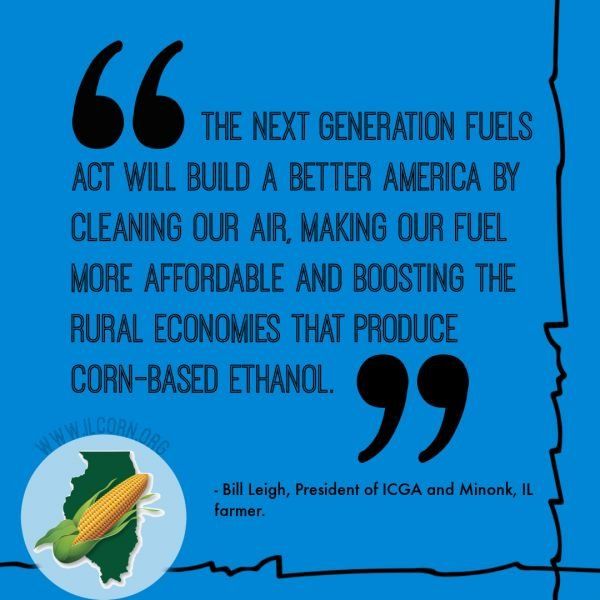Illinois Corn Growers Association Welcomes Bustos’ Next Generation Fuels Act

The Illinois Corn Growers Association (ICGA) welcomes legislation introduced by Rep. Cheri Bustos in the U.S. House of Representatives today that will boost long term corn demand for clean, affordable ethanol.
“We thank Congresswoman Bustos for her representation of the Illinois corn and ethanol industries and her recognition that corn farmers have a lot to offer as the U.S. considers new environment and energy policies. The Next Generation Fuels Act will build a better America by cleaning our air, making our fuel more affordable, and boosting the rural economies that produce corn-based ethanol,” said Bill Leigh, President of ICGA and Minonk, IL farmer.
The Next Generation Fuels Act recognizes the high octane, low carbon benefits of corn ethanol and builds a clean energy future that utilizes the infrastructure for liquid fuels that already exists in America. Consumer familiarity with liquid fuels is also a benefit that will aid in quick environmental gains and smooth transitions to a new fuel.
“The Next Generation Fuels Act is the biggest proposed energy policy change since the 2005 Renewable Fuel Standard and has the opportunity to impact corn farmers, ethanol producers, and rural America in a massive way. This policy should become the cornerstone of any future U.S. energy policy,” said Leigh.
The Act establishes a new 98 Research Octane Number (RON) standard for gasoline and requires that sources of additional octane result in at least 30 percent fewer greenhouse gas (GHG) emissions than unblended gasoline. This will ensure the progress already made to lower emissions through cleaner renewable fuels continues.
A new 98 RON would support mid-level blends like E25 and E30 which would generate new corn and ethanol demand.
Through advanced engine design features that take advantage of this new high octane fuel, automakers will be able to increase engine performance and significantly improve vehicle fuel efficiency. The fuel standard allows the automobile industry to design future vehicles that meet national Corporate Average Fuel Economy standards at lower costs to the consumer for both vehicles and fuel.
Due to its high-octane rating and other properties, ethanol is an excellent clean octane source. It is also the most cost-effective octane source, providing the greatest efficiency gains at the least cost to drivers while displacing the most harmful components of gasoline.
ICGA looks forward to working with Congress to continue to build support for the Next Generation Fuels Act and all policies that take greater advantage of ethanol’s benefits.
For more information on the benefits of high-octane fuels to our country and to corn farmers specifically, click here.
Download this news release here.






